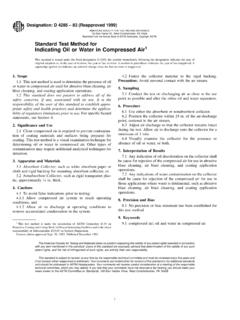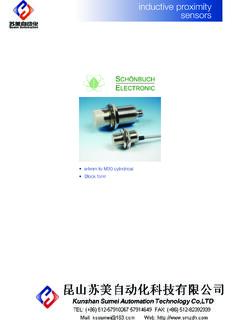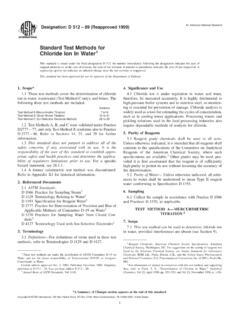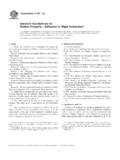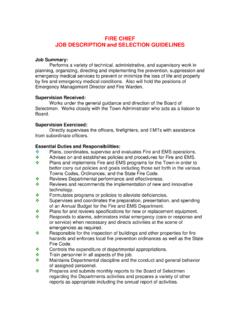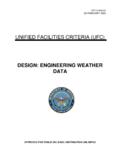Transcription of Standard Test Methods for Rubber …
1 Designation: D 297 93 (Reapproved 2002)e1 Standard Test Methods forRubber Products Chemical Analysis1 This Standard is issued under the fixed designation D 297; the number immediately following the designation indicates the year oforiginal adoption or, in the case of revision, the year of last revision. A number in parentheses indicates the year of last reapproval. Asuperscript epsilon (e) indicates an editorial change since the last revision or Standard has been approved for use by agencies of the Department of Sections , , , , , , , and were editorially updated in These test Methods cover the qualitative and quantita-tive analysis of the composition of Rubber products of the R family (see ).
2 Many of these test Methods may be applied tothe analysis of natural and synthetic crude Aconsists of general test Methods for use in thedetermination of some or all of the major constituents of arubber Bcovers the determination of specific polymerspresent in a Rubber The test Methods appear in the following order:Part A. General Test Methods :SectionsRubber Polymer Content by the Indirect Method11-13 Determinations and Report for the General Method14 and 15 Density16 Extract Analysis17-26 Sulfur Analysis27-33 Fillers Analysis34-40 Ash Analysis41-51 Part B.
3 Determination of Rubber The values stated in SI units are to be regarded asstandard. The inch-pound units given in parentheses are forinformation Standard does not purport to address all of thesafety problems, if any, associated with its use. It is theresponsibility of the user of this Standard to establish appro-priate safety and health practices and determine the applica-bility of regulatory limitations prior to precau-tionary statements are given in , , , , , , , and ; and and Referenced Standards.
4 D 982 Test Method for Organic Nitrogen in Paper andPaperboard2D 1416 Test Methods for Rubber from Synthetic Sources Chemical Analysis3D 1418 Practice for Rubber and Rubber Lattices Nomenclature3D 1646 Test Methods for Rubber Viscosity, Stress Relax-ation, and Pre-Vulcanization Characteristics (Mooney Vis-cometer)3D 3156 Practice for Rubber Chromatographic Analysis ofAntidegradants Antioxidants, Antiozonants, and Stabiliz-ers3D 3452 Practice for Rubber Identification by Pyrolysis-Gas Chromatography3D 3677 Test Methods for Rubber Identification by Infra-red Spectrophotometry3D 4483 Practice for Determining Precision for Test MethodStandards in the Rubber and Carbon Black Industries3E 11 Specification for Wire-Cloth Sieves for Testing Pur-poses4E 131 Terminology Relating to Molecular Spectroscopy5E 200 Practice for Preparation.
5 Standardization, and Stor-age of Standard and Reagent Solutions for ChemicalAnalysis6E 422 Test Method for Measuring Heat Flux Using aWater-Cooled Calorimeter7E 443 Test Method for Sulfur in Organic Compounds byOxygen Flask Combustion63. The nomenclature and abbreviations usedfor natural and synthetic rubbers are in accordance withPractice D of Reagents Reagent grade chemicals shall beused in all tests . Unless otherwise indicated, it is intended that1 These test Methods are under the jurisdiction of ASTM Committee D11 onRubber and are the direct responsibility of Subcommittee on edition approved Dec.
6 10, 2002. Published January 2003. Originallyapproved in 1928. Last previous edition approved in 1998 as D 297 93 (1998).2 Discontinued; see1982 Annual Book of ASTM Standards, Part Book of ASTM Standards, Vol Book of ASTM Standards, Vol Book of ASTM Standards, Vol Book of ASTM Standards, Vol Book of ASTM Standards, Vol ASTM International, 100 Barr Harbor Drive, PO Box C700, West Conshohocken, PA 19428-2959, United reagents shall conform to the specifications of the Commit-tee on Analytical Reagents of the American Chemical Society,where such specifications are grades may beused.
7 Provided it is first ascertained that the reagent is ofsufficiently high purity to permit its use without lessening theaccuracy of the of Water Unless otherwise indicated, referencesto water shall be understood to mean distilled water or water ofequal Concentration of Acids and Ammonium Hydroxide Whenacids and ammonium hydroxide are specified by name orchemical formula only, it is understood that concentratedreagents of the following densities or concentrations areintended:Density,Mg/m3 Acetic acid, HC2H3O2( %) acid, acid, acid, HF (49 %) acid, acid, H3PO4(85 %) acid, hydroxide, desired densities or concentrations of all other concen-trated acids are stated whenever they are Concentrations of diluted acids and ammonium hydroxide,except when standardized, are specified as a ratio stating thenumber of volumes of the concentrated reagent to be added toa given number of volumes of water, as in the followingexample.
8 HCl (1 + 9) means 1 volume of concentrated HCl(density ) mixed with 9 volumes of water. Acids shall beadded to water slowly, with Solutions Concentrations of Standard solu-tions are expressed as normalities or as volume of solution thatreacts with or contains a given mass of material being used ordetermined, for example: , or CuSO4solution (1 cm3= g Cu). Solutions Concentrations of non-standardized solutions prepared by dissolving a given mass ina solvent are specified in grams of the reagent (as weightedout)/dm3of solution, and it is understood that water is thesolvent unless otherwise specified, for example: NaOH (10g/dm3) means 10 g of NaOH dissolved in water and dilutedwith water to 1 dm3(Note 1).
9 In the case of certain reagents theconcentration may be specified as a percentage by mass, forexample: ethanol (50 %) means a solution containing 50 g ofethanol per 100 g of solution. Other nonstandardized solutionsmay be specified by name only, and the concentration of suchsolutions will be governed by the instructions for their Whenever a hydrated salt is used in the preparation of areagent (for example, BaCl2 2H2O) the preparation of the reagent isdescribed in detail. When an anhydrous salt is used in preparing a simpleaqueous solution the reagent is listed by title only and details of thepreparation are not A.
10 GENERAL TEST METHODS6. Scope and The general test Methods described cover the analysis ofmany types of Rubber products to determine the amount andtype of nonrubber constituents and to calculate indirectly fromthese data the amount of Rubber The applications and limitations of the test Methods toanalysis of specific types of Rubber products are given in thescopes of the various test Methods . Application to types ofrubber products not specified in the scope of a particular testmethod shall be verified by application to a control of knownand similar Special test Methods for analysis are given for rubberproducts containing glue, free carbon, antimony, lead, mineraloil, waxy hydrocarbons, and barium For the determination of the amount of a Rubber polymerpresent in a Rubber product, an indirect test method is given bywhich the nonrubber constituents are determined individuallyor in groups.




